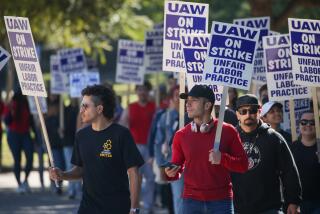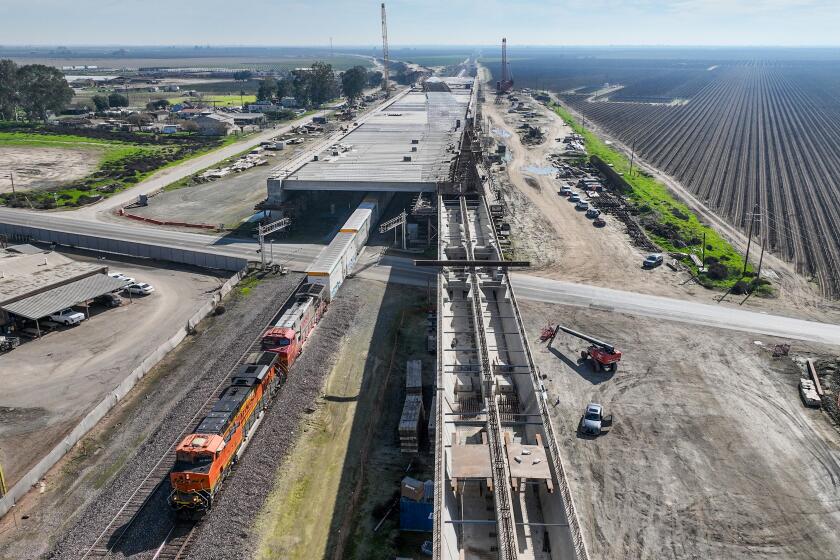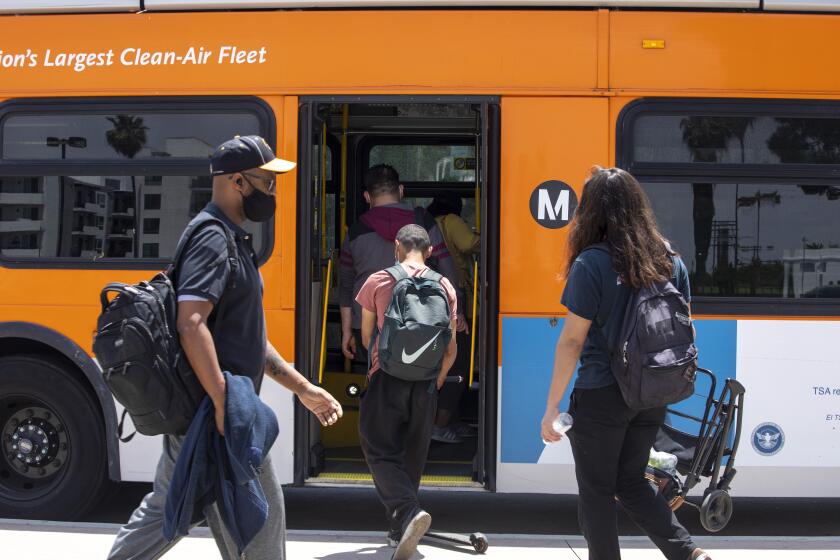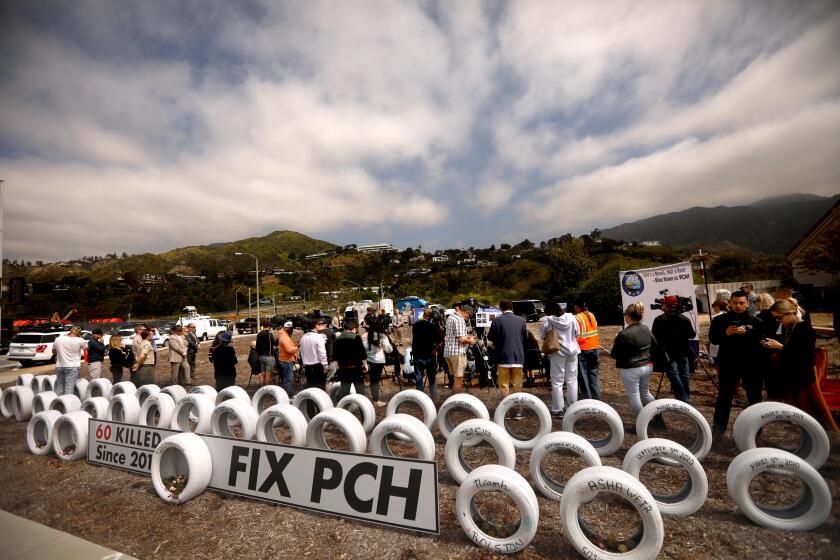Union Pacific Fiddles as Ports, Shippers Burn
The Union Pacific Railroad is going far to prove that the private sector cannot be relied on to serve the public interest.
The unprecedented delays and mounting losses for shippers through the ports of Los Angeles and Long Beach due to the railroad’s mismanagement in the aftermath of its 1996 merger with the Southern Pacific are disgraceful--and extremely costly.
“This is the worst congestion we’ve ever had,” says Don Wylie, director of trade for the Port of Long Beach. Container carriers that normally leave the port, unload at Los Angeles rail yards and return within 24 hours are now gone for three to seven days as UP’s confused crews flounder around trying to keep track of them.
Freight-unloading delays are severe; 13 vessels have been sitting at anchor for days in the harbors of Long Beach and Los Angeles, each costing shippers $400,000 a day. Freight is being diverted to Oakland, and shippers worldwide are contemplating permanent diversions of their business.
“We need action now,” says Larry Keller, executive director of the Port of Los Angeles. “The railroad promises improvement by Thanksgiving. I’m skeptical they can do anything by then.”
Yet UP Chairman and Chief Executive Richard Davidson hasn’t even communicated to the port, much less visited the site of the economic disaster.
In fairness, Davidson’s attention has been drawn to even greater problems in Houston, where railroad workers have died in train collisions in chaotic rail yards. The federal Surface Transportation Board has directed smaller railroads in the Houston area to move freight on UP tracks to relieve congestion.
Significantly, both areas where UP--the nation’s largest railroad, at roughly $10 billion in revenue--is having the most trouble are in territories acquired with Southern Pacific.
Under pressure to cut costs after its $5.4-billion purchase of Southern Pacific, which had been in decline for years, UP fired Southern Pacific administrators--”administrative people and clerical workers,” a UP spokesman calls them--and retired old Southern Pacific locomotives.
Then UP found it couldn’t do the administrative jobs of the fired personnel and that it needed the Southern Pacific equipment to handle increased freight traffic. “They underestimated the importance of SP’s management,” says Sam Mansour, an ex-Southern Pacific official now with J.L. Patterson Inc., a rail consulting firm in Orange.
UP’s mistaken judgments are estimated to have cost the U.S. $1 billion so far in losses to farmers, chemical companies and movers of containerized freight to and from the United States.
Congressional delegations from Texas, Kansas and Nebraska have protested UP’s dereliction to the Transportation Department and gotten some help for their states. California’s congressional delegation has been largely silent. And Philip Anschutz, now vice chairman of UP after making $1 billion in the sale of Southern Pacific, hasn’t done anything to help the city in which he’s building a sports arena. So the chaos continues here.
Omaha-based UP says it’s trying to get back on track. “We’re hiring 2,000 rail workers and investing $2 billion more in locomotives and other equipment,” says a UP spokesman.
But for the most part, the railroad’s attitude is truculent. It blames Southern Pacific’s old equipment for its troubles, and it even blames an increase in business. “The growth of freight through the California ports caught us by surprise,” says UP spokesman Mike Furtney.
Still, UP admits no liability. “Shippers can sue, but this is no different from Joe’s Trucking failing to make a delivery because of a flat tire,” Furtney says.
The analogy is wrong--not to mention that “sue us” is not an attitude likely to serve the public interest. The Union Pacific is not a small truck operator but a giant railroad with near monopoly control of business on 36,000 miles of track in the Western United States, including 80% of the rail traffic between the U.S. and Mexico.
UP gained that dominance last year when its acquisition of Southern Pacific was approved by the Surface Transportation Board, despite objections from the Justice Department and numerous shippers.
UP was not alone in gaining market power. The Burlington Northern and the Santa Fe railroads had merged earlier. Now the union of the CSX (the onetime Chesapeake and Ohio plus other railroads) and the Norfolk & Western is pending. And both are bidding to acquire Conrail, the government-owned collection of once-bankrupt Northeastern railroads.
At the end of this consolidation stage, the U.S. could have three major railroads. And transportation experts see a need to reduce even that number.
“The chief reason for combining the railroads is to give them the ability to earn a good return so they can afford the capital investments to further modernize the rail system,” says John Taylor, professor of transportation and logistics at Wayne State University in Detroit.
To be sure, railroads have improved their position against trucks in recent years by developing flatbed trains that can move 60 containers at a time. Railroad rates in some cases can be 20% to 30% cheaper than trucks for comparable merchandise.
The dream is for a single transcontinental line, says Taylor, “so we can avoid the inefficiency of handing off freight at Chicago. Logistics companies want seamless delivery.”
The dream may be of a giant railroad as a public utility, but the reality is UP’s mismanaged and indifferent system. The Defense Department last week ruled that UP would get no military shipments for at least six months because of the railroad’s negligence in leaving M-1 tanks untended at a siding.
There should be a better way than monopoly, and there is. Isabel Benham, a New York-based longtime analyst of the rail industry, advocates an open access system. The nation’s trackage would be put into a common carrier company in which the railroads would own equity. Then any shipper--United Parcel Service, farm cooperatives, chemical companies or Wal-Mart--could could put its car on the tracks and better control its deliveries.
Open access systems already work for natural gas pipelines and are being introduced for deregulated electricity. Rail open access is under discussion in Washington but is theoretical for the moment because the railroads oppose it.
UP’s attitude is that the current mess is a short-term cost. Davidson tells security analysts that lower earnings in the fourth quarter will reflect the costs of the troubles but that 1998 will see recovery. Many analysts agree, issuing long-term “buy” recommendations on the stock, which is only 18% below its 52-week high. “In the short term, UP will get through its troubles, and long-term it has great opportunities,” says analyst Jill Evans of J.P. Morgan Securities.
Unfortunately, business people held hostage by the railroad’s incompetence can’t feel the same confidence. “The railroad tells us, ‘We can’t tell you when you’ll get your shipment.’ We have to find other ways to ship,” says Richard Rodriguez, marketing director of Mercado Latino, a grocery company in Industry.
Yet the railroad, blaming an emergency of its own making, is dictating to the ports of Los Angeles and Long Beach just what kind of freight it will move and when.
Is this any way to run an economy, much less a railroad? The answer is no!
(BEGIN TEXT OF INFOBOX / INFOGRAPHIC)
Union Pacific Corp.
Holding company for Union Pacific Railroad
* Headquarters: Dallas for the holding company, Omaha for the railroad
* Chairman/CEO: Richard Davidson
* Number of employees: About 72,000
* 1997 revenue: $11 billion (estimate)
* 1997 profit: $716 million (estimate)
* Friday’s closing stock price: $59.88
More to Read
Start your day right
Sign up for Essential California for news, features and recommendations from the L.A. Times and beyond in your inbox six days a week.
You may occasionally receive promotional content from the Los Angeles Times.






